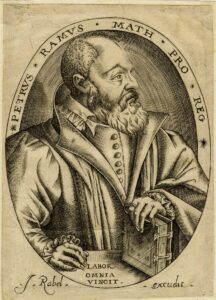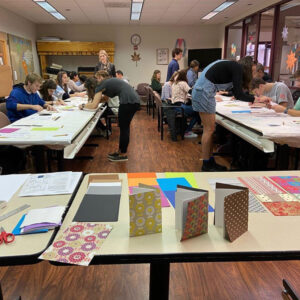
First-year college students often come into literature-focused composition classrooms predisposed to fear “old books.” However, my students this past semester quickly overcame that fear as they tackled the writings of John Milton. Teaching “old books” is an excellent way to help young adults contextualize themselves in their contemporary world. Jeffrey Jerome Cohen writes, “the past is not past, is not an absolute difference. Nor is the past conjoined to the present in continuity, in dreary sameness. Past, present, and future are a knot, thick with possibility even while impossible to fully untangle” (131–32). The uncanny familiarity and alien quality of the past Cohen describes is a challenge early modernists face when incorporating their field of study into the composition classroom. In the current literature undergraduate classroom, it is rather en vogue contextualize readings through the experiences of twenty-first century students rather than the texts’ original cultural circumstances. Cohen’s framework for bringing texts into our contemporary teaching means we have to not only connect authors’ words with the present, but also their historical realities and practices as well. This is exactly what I strove to do in my English 1102 course this past semester on humanism in John Milton’s Paradise Lost. In it, my students examined Milton’s writings in the context of early modern education and oratory. My approach turned out to be a hugely successful method for teaching rhetoric and multimodality in part through a project in which students created their own argumentative pamphlets. This assignment helped my students understand audience and the myriad ways we can communicate with them, and it also increased their understanding of Milton’s style and lasting legacy.
The desire to make early modern literature relevant to college students is shared by many. Brown et. al., for instance, reinforces the importance of bringing Shakespeare to the twenty-first century by arguing that early modern literature has “found new articulation, and [has] provided a medium through which the concerns and experiences of our own age can be expressed” (1). While the idea that Shakespeare’s plays transcend their time and are easily adapted to various cultures is not a new one and is certainly a true and relevant point, to teach them as a reflection of twenty-first-century cultures often does a disservice to the material. This method can be certainly effective at making the literature enticing to undergraduates, but it risks losing the intended nuance of the works. And although many early modernists of course provide historical context for their assigned readings, affording that socio-historical context a prominent position in the undergraduate classroom is less common. Kate McLuskie highlights why this method of modernizing early modern literature is so popular:
Academic emphasis on historical knowledge, theoretical analysis, and discursive assessment allows [Shakespeare] to be categorized as the antithesis of ‘fun,’ not least because the innovations of academic research produce findings that are necessarily counterintuitive and resistant to essentialist ideas of the transhistorical human that can be directly intuited from students’ personal experience. (133)

No Fear Shakespeare: Hamlet (2003) by Sparknotes
McLuskie responds in large part to the way students are educated in high school when it comes to early modern literature. Often students arrive in the college classroom predisposed to fear these texts because they see such old works as inaccessible. This is, in my opinion, due to a reliance on popular books, such as Sparknotes’s popular series, No Fear Shakespeare, that carry such apprehension in their very titles, and are relied upon on for their easy-to-understand adaptation of the text. However, because No Fear Shakespeare “presents parallel-text versions of Shakespeare’s plays with the original language published alongside a modern translation,” students also come to rely on “translations” of Shakespeare into contemporary English, a practice which eliminates most of the historically contextual elements of the language (Gorlewski and Shoemaker 111). Even though many of our students come to us having “learned” Shakespeare in this manner (and subsequently falsely label his language “Old English”) that is no reason for us to continue in this manner.
Raising the analytical expectations of my students allowed me to see how they can move from the high school classroom to a college with relative ease. For example, as one of my students was walking us through the events of Book 5 of Paradise Lost, she described Adam’s response to Eve’s anxiety at her nightmare by saying, “and Adam is like, well, sometimes it be like that.” Students being able to conceptually translate plot points into their own parlance is certainly helpful (as well as entertaining), but the important part of this anecdote to me is that she managed to do so without a No Fear approach. Once students enter the college classroom, we do not need to give in to the supposition that students cannot cope with this literature; rather by challenging them, we can provide them with the confidence to tackle these texts and concepts.

“Student Pamphlets” (2020) by Mary Grace Elliott
Teaching Milton this semester in my English 1102 class has provided me with the opportunity to create a course that effectively blends twenty-first-century early modern argumentation. My course, “Freedom from Educational Tyranny: Humanist Education in Paradise Lost,” started with Milton’s pamphlet Areopagitica, a famous treatise against book licensure that, incidentally, was an important inspiration for many early American documents like the Declaration of Independence. In response to their reading of this challenging text, my students then were required to create their own arguments as physical quarto pamphlets at the Robert C. Williams Paper Museum in the oratory style of Areopagitica. They were assigned socio-cultural topics important in the twenty-first century around which, in small groups, they created a pamphlet war; and they were required to structure their arguments in the style of early modern humanist oratory. By assuming this tactic, students were not translating their ideas into early modern language but rather using the cultural practice of seventeenth-century oratory to structure their arguments, and, by so doing, naturally creating that connection between past and present, even while confronting heretofore-unfamiliar terminology.
Early modern humanist oratory—based on Cicero’s formula for well-structured arguments and popularized by the sixteenth-century pedagogue Peter Ramus—follows a strict formula. This formula is an incredible teaching tool for understanding the rhetorical triangle as well as a kind of basis for the now-popular five-paragraph essay. Ramus prescribes six sections as follows:
- exordium: a direct address to the speaker/writer’s intended rhetorical audience;
- narratio: similar to the introduction of a five-paragraph essay—an explanation of the context of the coming argument;
- partitio: the thesis—generally expanded out into a few sentences that provide a specific roadmap of the argument;
- confirmatio: the speaker/writer’s affirmative reasons/evidence for their stance;
- refutatio: a section disproving anticipated opposing points;
- perortio: the conclusion.

“Petrus Ramus” (1586-1603) by Jean Rabel, courtesy of the British Museum CC BY-NC-SA 4.0
In my course, students used this framework to identify each segment of Areopagitica. With that model in mind, they created their own arguments around twenty-first-century issues. Returning to Cohen’s words—“the past is not the past”—students were able to connect the early modern practices at play in the Areopagitica with the pamphlets they produced, encouraging them see the presence of early modern practices in their own writing styles without translating the practice.
Students were grouped with two or three others around a single issue. No two groups were allowed to share a stance, so many of my students argued points that they themselves did not believe. Each group member had to try to reach the particular audience of their choosing. By structuring their essays in the Ramist style, addressing these audiences became the primary focus of the project. Current-day academic essays tend to begin their arguments in the narration merely assuming the exordium. By including a traditional exordium, students were forced to state a specific audience. This kept their pamphlets on track and helped them to consider their own ethos—i.e. the rhetorical moves they needed to make to ensure their chosen audiences were receptive to their ideas. One of my favorite examples of this was a student who wrote about decreasing the minimum wage (a stance he did not actually agree with) through humor:
M. O. N. E. Y. I love my money, and my money loves me. Don’t you love your money – doesn’t your money love you? Of course, you do, and of course it does, you greedy bastard. Am I going to turn you into the conservative you never thought you’d be with my ideas? Maybe not. Am I going to show you how to make more money? That depends – do you want me to? Am I going to use this piece to try and solicit corporate America to become my Valentine’s Day date? That’s for you to find out.
Right away, he reaches out to a young, potentially progressive audience. His exordium entertains and invites in an audience he acknowledges might be skeptical. And while his diction is decidedly not that of Milton in Areopagitica, his pamphlet carries the same kind of bombastic tone. For example, Milton dramatically states, “a good Booke is the pretious life-blood of a master spirit, imbalm’d and treasur’d up on purpose to a life beyond life,” suggesting a kind of magical personhood inherent in books (Areopagitica). My student similarly suggests that corporate America is a kind of “life-blood” in that it could be his Valentine’s date.
Accordingly, my students’ reflections on this assignment were astute, showing dramatic growth with respect to audience. I had imagined that their understanding of audience would grow, but not necessarily in a way that was obvious to them. However, the process helped them to explicitly grasp this concept. One student wrote, “I actually found that using this method [Ramus’] made it a lot easier to construct a persuasive piece”; another agreed, asserting that “Milton’s rhetorical style of explicitly addressing your audience was something I found compelling and was influenced by because the message and purpose of the paper are more effectively communicated.” Moreover, this first assignment colored the entire course by helping students to continue to identify both strong and weak arguments made by various characters throughout Paradise Lost. One student, when considering demonic arguments in Book 2 of the epic, opined,
by looking at how demons structure their arguments, you can learn a lot of tricky ways to give yourself an edge. One of the main points I took from Mammon’s argument (which I thought was magical) was the use of timing. Right after Belial [presents] the idea of not attacking heaven and instead just staying in hell, Mammon [speaks] up and [builds] on that point. By doing this he [pre-establishes a] base of agreement with the [demons] who had agreed with Belial. I had never thought about this before and would normally just interject depending on my attitude, either early out of aggression or later out of fear. Now I know to shelve my emotions and instead pay attention for the right time to strike.

“Students Making Pamphlets” (2020) by Mary Grace Elliott
What I love about this final reflection is that the student found new tactics and practices for his work within the course and was even able to take what he learned outside the class. In fact, throughout the semester, many students came to class eager to share Miltonic themes and early modern rhetorical styles that they saw in the media around them.
My purpose in sharing this assignment is to demonstrate that we do not need to contemporize the message or language in these early modern texts to make this literature “relevant” or accessible to our students. We continue to read this literature because it remains relevant. There are early modern practices, like oratory, that we seem to have forgotten but that are still useful for today’s students. Having my students engage in their own pamphlet wars through a multi-modal project helped them both to learn to understand and use rhetoric as well as to understand the early modern undercurrents still present in today’s common argumentative structures. Our students at Georgia Tech are overwhelmingly engineers and scientists, often coming into the classroom with a skepticism towards “Literature” in general, and early modern literature in particular. And yet, by incorporating these foundational works into stimulating multi-modal assignments—without removing their original contexts—we can see real development in their writing and stimulate a genuine interest in rhetoric, both old and new.
Works Cited
Brown, Sarah Annes, et al. Reinventing the Renaissance: Shakespeare and His Contemporaries in Adaptation and Performance. Palgrave Macmillan, 2013.
Cohen, Jeffrey Jerome. “In the Middle of the Early Modern.” Journal for Early Modern Cultural Studies, vol. 13, no. 3, 2013, pp. 128.
Gorlewski, Julie and Brandon Shoemaker. “Research for the Classroom: To Read or Not to Read: Five Approaches to Teaching Shakespeare.” The English Journal, vol. 102, no. 4, Mar. 2013, pp. 111-14.
McLuskie, Kate. “Dancing and Thinking: Teaching ‘Shakespeare’ in the Twenty-First Century.” Teaching Shakespeare: Passing It On. Edited by G.B. Shand, Wiley-Blackwell, 2009, pp. 121–41.
Milton, John. Areopagitica. The John Milton Reading Room. Edited by Thomas H. Luxon, Dartmouth College, 2020. http://www.dartmouth.edu/~milton/reading_room/areopagitica/text.html.
